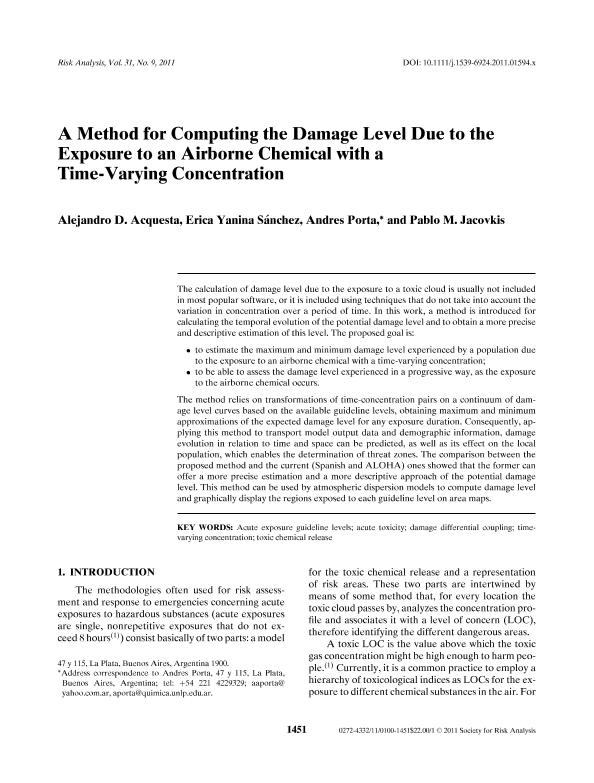Mostrar el registro sencillo del ítem
dc.contributor.author
Acquesta, Alejandro Dante

dc.contributor.author
Sánchez, Érica Yanina

dc.contributor.author
Porta, Andres A.
dc.contributor.author
Jacovkis, Pablo Miguel

dc.date.available
2020-01-23T19:38:33Z
dc.date.issued
2011-09
dc.identifier.citation
Acquesta, Alejandro Dante; Sánchez, Érica Yanina; Porta, Andres A.; Jacovkis, Pablo Miguel; A method for computing the damage level due to the exposure to an airborne chemical with a time-varying concentration; Wiley Blackwell Publishing, Inc; Risk Analysis; 31; 9; 9-2011; 1451-1469
dc.identifier.issn
0272-4332
dc.identifier.uri
http://hdl.handle.net/11336/95688
dc.description.abstract
The calculation of damage level due to the exposure to a toxic cloud is usually not included in most popular software, or it is included using techniques that do not take into account the variation in concentration over a period of time. In this work, a method is introduced for calculating the temporal evolution of the potential damage level and to obtain a more precise and descriptive estimation of this level. The proposed goal is: • to estimate the maximum and minimum damage level experienced by a population due to the exposure to an airborne chemical with a time‐varying concentration; • to be able to assess the damage level experienced in a progressive way, as the exposure to the airborne chemical occurs. The method relies on transformations of time‐concentration pairs on a continuum of damage level curves based on the available guideline levels, obtaining maximum and minimum approximations of the expected damage level for any exposure duration. Consequently, applying this method to transport model output data and demographic information, damage evolution in relation to time and space can be predicted, as well as its effect on the local population, which enables the determination of threat zones. The comparison between the proposed method and the current (Spanish and ALOHA) ones showed that the former can offer a more precise estimation and a more descriptive approach of the potential damage level. This method can be used by atmospheric dispersion models to compute damage level and graphically display the regions exposed to each guideline level on area maps.
dc.format
application/pdf
dc.language.iso
eng
dc.publisher
Wiley Blackwell Publishing, Inc

dc.rights
info:eu-repo/semantics/openAccess
dc.rights.uri
https://creativecommons.org/licenses/by-nc-sa/2.5/ar/
dc.subject
Time-varying concentration
dc.subject
Acute toxicity
dc.subject
Toxic chemical release
dc.subject
Acute exposure guideline levels
dc.subject
Damage differential coupling
dc.subject.classification
Salud Pública y Medioambiental

dc.subject.classification
Ciencias de la Salud

dc.subject.classification
CIENCIAS MÉDICAS Y DE LA SALUD

dc.title
A method for computing the damage level due to the exposure to an airborne chemical with a time-varying concentration
dc.type
info:eu-repo/semantics/article
dc.type
info:ar-repo/semantics/artículo
dc.type
info:eu-repo/semantics/publishedVersion
dc.date.updated
2020-01-22T19:58:17Z
dc.journal.volume
31
dc.journal.number
9
dc.journal.pagination
1451-1469
dc.journal.pais
Reino Unido

dc.journal.ciudad
Londres
dc.description.fil
Fil: Acquesta, Alejandro Dante. No especifica;
dc.description.fil
Fil: Sánchez, Érica Yanina. Consejo Nacional de Investigaciones Científicas y Técnicas; Argentina
dc.description.fil
Fil: Porta, Andres A.. No especifica;
dc.description.fil
Fil: Jacovkis, Pablo Miguel. No especifica;
dc.journal.title
Risk Analysis

dc.relation.alternativeid
info:eu-repo/semantics/altIdentifier/url/http://onlinelibrary.wiley.com/doi/10.1111/j.1539-6924.2011.01594.x/abstract
dc.relation.alternativeid
info:eu-repo/semantics/altIdentifier/doi/http://dx.doi.org/10.1111/j.1539-6924.2011.01594.x&ArticleID=815543
Archivos asociados
